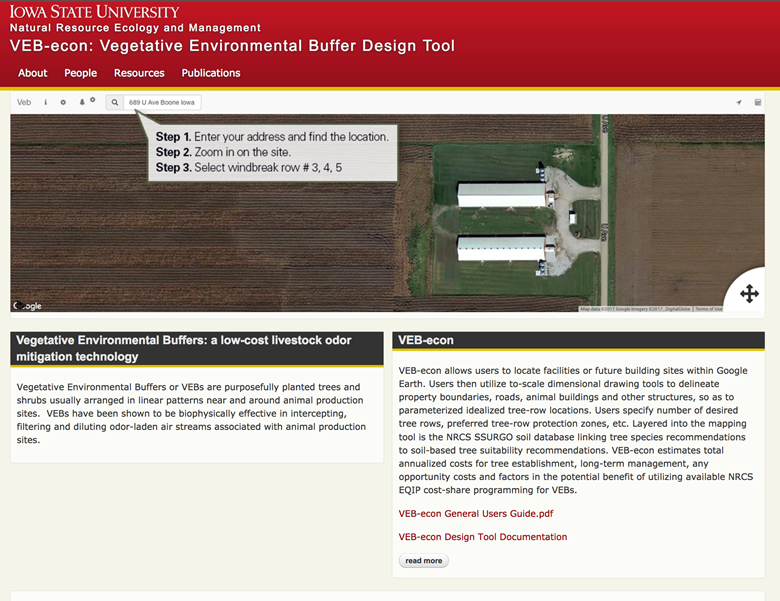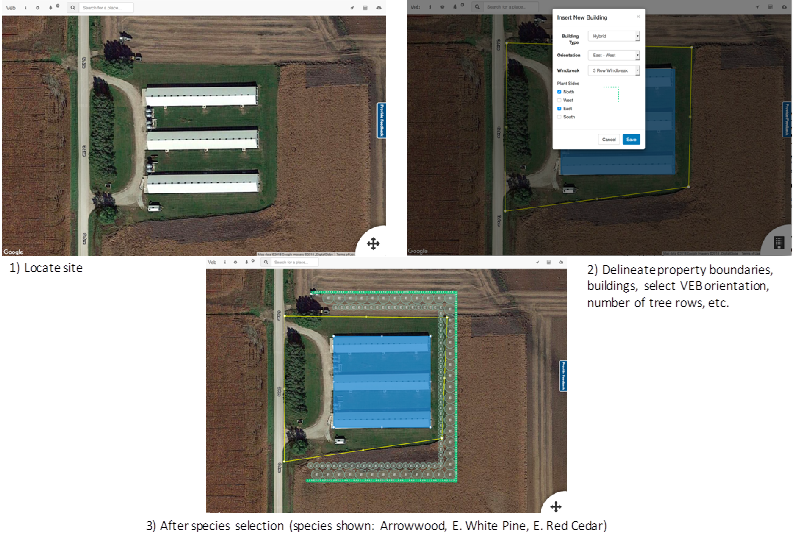 |
December 2018
|
December 2018 // Volume 56 // Number 7 // Tools of the Trade // v56-7 tt3
VEB-econ: An Outreach Tool for Designing Vegetative Environmental Buffers
Abstract
Vegetative environmental buffers, or VEBs, are rows of trees and shrubs purposefully planted to mitigate livestock odor. In this article, we present VEB-econ, a free-to-use geographic information system–based decision support tool Extension professionals can implement when working with livestock producers in designing site-specific VEBs. A soil database links tree and shrub species recommendations to soil-based suitability guidelines. VEB-econ estimates annualized cost for tree establishment and management and opportunity costs and factors in potential Natural Resources Conservation Service cost-share payments. Additionally, VEB-econ can be used to design field windbreaks. VEB-econ is designed specifically to be useful to Extension professionals and other air quality stakeholders.
Introduction
With regard to environmental quality concerns in agriculture, Extension professionals have long served as key advisors who extend research findings and general technical and/or financial guidance to stakeholders (Bridges, 2010). To that end, there is an interest within the Extension community regarding cutting-edge decision support tools, such as a geographic information system (GIS) application, that can be used to guide interactions with their stakeholders and facilitate data-driven decision making (Watermolen, Andrews, & Wade, 2009). This article introduces to the Extension community a GIS-based decision support tool that bridges these two outreach goals in the context of Extension professionals' working directly with livestock and poultry producers to help them plan for enhanced odor management through the use of tree buffers.
The mitigation of odors associated with livestock and poultry production is a persistent and challenging environmental issue that has vexed the Extension community in the U.S. Midwest (Harmon & Rieck-Hinz, 2014; Key, McBride, Ribaudo, & Sneeringer, 2011). Animal producers can use various technologies and management approaches to help manage production site odors (e.g., Maurer et al., 2016), yet cost and lack of planning capacity (particularly in retrofit situations) can be barriers to cost-effective odor mitigation (Williams, 2009). A low-cost odor mitigation technology that is increasingly being adopted by livestock and poultry producers throughout the United States is the vegetative environmental buffer (VEB). A VEB is a strategically planted tree windbreak that can provide odor filtration and dilution benefits to downwind stakeholders (Tyndall & Larsen, 2013). Livestock odor (e.g., volatile organic compounds) moves largely by way of windborne particulates (Tyndall & Colletti, 2007). As a tertiary odor mitigation technology, VEBs are incrementally effective in biophysically reducing downwind concentrations of odor through particulate interception or otherwise modifying air flow (Tyndall & Colletti, 2007; Willis et al., 2017). VEBs also can improve site-level aesthetics, which in turn may positively affect neighbor relations (Sullivan, Anderson, & Lovell, 2004).
VEB-econ Decision Support Tool
We have created a web-based VEB design program called VEB-econ for Extension professionals to use to aid livestock producers in the design of VEB systems that suit particular production systems and landowner goals for VEB use (e.g., odor mitigation, aesthetics). This tool bridges two disciplinary challenges in Extension in that livestock specialists often do not have a lot of experience with trees and forestry specialists often do not have experience with livestock facilities and site-level ventilation needs. Within VEB-econ's high-resolution photomapping GIS (which uses Google Earth), users locate existing or planned animal production sites and select the applicable type of production system (e.g., naturally or mechanically ventilated buildings) and building orientation. Users then arrange tree rows based on goals and select VEB characteristics such as number of tree rows and tree/shrub species. VEB-econ accounts for building ventilation needs and potential snow deposition so as to prevent ventilation or snow hazards and has default minimum tree row distances from buildings/roads. Included in the mapping tool is the U.S. Department of Agriculture Natural Resources Conservation Service (NRCS) SSURGO soil database (https://sdmdataaccess.sc.egov.usda.gov/?referrer=Citation.htm-SSURGOLink), which displays the soil series present where trees/shrubs would be planted. In addition, specific to the state of Iowa, the tool links tree species recommendations to soil-based suitability guidelines (see Iowa Department of Natural Resources, 2014). GPS data are downloadable and aid establishment actions. Figures 1 and 2 show VEB-econ's web interface and examples of various graphics and outputs.
Figure 1.
VEB-econ Website Front Page
![]()

Figure 2.
Example Vegetative Environmental Buffer (VEB) Design Actions and Visualizations

Critical to the adoption decision process is the need for up-to-date and transparent cost information, yet relevant cost information is often difficult for decision makers and their advisors (e.g., Extension personnel) to find (Tyndall & Roesch, 2014). Therefore, VEB-econ estimates total annualized costs for site preparation, tree establishment, and long-term management and any opportunity costs a producer may experience. Costs for VEB systems are highly variable and dependent on specific VEB design, so the cost assessments presented are site specific and organized by categories of cost (e.g., upfront versus long-term cost; total cost and annualized cost) so as to better inform investment needs. Financial data with regard to site preparation, establishment, and management are based on detailed partial budgets designed specifically for VEB systems (Tyndall & Grala, 2009). Tree and shrub stock costs per species are based on averaged listed costs from a survey of regional public and private tree nurseries; users can examine costs of options from bare root seedlings to the largest containerized tree/shrub stock offered regionally. Financial data are updated annually. Also, because government cost-share incentives are influential in environmental technology adoption, VEB-econ factors in the financial effects of using available NRCS Environmental Quality Incentive Program (EQIP) cost-share programming for VEBs (Iowa EQIP 2018 payments for Practice Code 380, Windbreak/Shelterbelt Establishment).
Additionally, VEB-econ can be used to design field windbreaks or simple tree plantings that address other management goals, such as reducing wind erosion, mitigating spray or pollen drift, protecting sensitive crops, snow management, live fencing, protecting homes or recreation sites from wind, and so on (Brandle, Hodges, Tyndall, & Sudmeyer, 2009).
Conclusion
Our fully functional beta version of VEB-econ runs on modern browsers and devices (Windows and IOS) and can be found online and used for free at https://veb.nrem.iastate.edu/. The website includes a portal to the software, a user's guide with step-by-step screen-capture illustrated instructions, documentation regarding default VEB design parameters and financial data, and various published peer-reviewed and Extension materials that overview the science and general application of VEBs and windbreaks. As of this writing, the soil-based species recommendations and financial data provided by VEB-econ are specific to the state of Iowa (the nation's leader in hog and egg production), but later versions of the tool (planned for 2019) will allow for guided use in Illinois, Minnesota, and Missouri. Nevertheless, VEB-econ is currently usable as a basic VEB or windbreak design tool for properties located anywhere in the United States, and the website provides all the additional information required for Extension personnel to make outputs relevant to their clients. VEB-econ is designed to be useful to Extension professionals, producers they work with, farm/forest management consultants, tree nursery personnel, and other key air quality stakeholders and/or those simply interested in planting trees for multiple reasons.
Acknowledgments
The project described herein was supported by funding from the Iowa Pork Producers Association and the National Pork Board, Project #NPB 13-243 (A Pork Checkoff Funded Research Grant).
References
Brandle, J. R., Hodges, L., Tyndall, J. C., & Sudmeyer, R. A. (2009). Windbreak practices. In North American agroforestry: An integrated science and practice (2nd ed.) (pp. 75–104). Madison, WI: American Society of Agronomy, Inc.
Bridges, C. A. (2010). Watershed-scale dynamics of Tennessee farmland enrollment in the Conservation Reserve Program: Implications for environmental Extension. Journal of Extension, 48(2), Article 2IAW4. Available at: https://joe.org/joe/2010april/iw4.php
Harmon, J., & Rieck-Hinz, A. (2014). New tool evaluates options for reducing odors in livestock operations. Ames, IA: Iowa State University Extension and Outreach.
Iowa Department of Natural Resources. (2014). 2014 Iowa woodland suitability recommendations, February 6, 2014.
Key, N., McBride, W. D., Ribaudo, M., & Sneeringer, T. (2011). Trends and developments in hog manure management: 1998–2009. U.S. Department of Agriculture Economic Research Service, Economic Information Bulletin Number 81, 2011.
Maurer, D., Koziel, J. A., Harmon, J. D., Hoff, S. J., Rieck-Hinz, A. M., & Andersen, D. S. (2016). Summary of performance data for technologies to control gaseous, odor, and particulate emissions from livestock operations: Air management practices assessment tool (AMPAT). Data in Brief, 7, 1413–1429.
Sullivan, W. C., Anderson, O. M., & Lovell, S. T. (2004). Agricultural buffers at the rural-urban fringe: An examination of approval by farmers, residents, and academics in the Midwest United States. Landscape and Urban Planning, 69, 299–313.
Tyndall, J. C., & Colletti, J. P. (2007). Mitigating swine odor with strategically designed shelterbelt systems: A review. Agroforestry Systems, 69(1), 45–65.
Tyndall, J. C., & Grala, R. C. (2009). Financial feasibility of using shelterbelts for swine odor mitigation. Agroforestry Systems , 76, 237–250.
Tyndall, J. C., & Larsen, G. L. (2013). Vegetative environmental buffers for odor mitigation. Pork information gateway. US Pork Center of Excellence. PIG 10-2-15.
Tyndall, J. C., & Roesch, G. (2014). A standardized approach to the financial analysis of structural water quality BMPs. Journal of Extension, 52(3), Article 3FEA10. Available at: https://www.joe.org/joe/2014june/a10.php
Watermolen, D. J., Andrews, E., & Wade, S. (2009). Extension educators can use Internet GIS and related technologies. Journal of Extension, 47(5), Article 5FEA2. Available at: https://www.joe.org/joe/2009october/a2.php
Williams, C. M. (2009). Development of environmentally superior technologies in the US and policy. Bioresources Technology, 100, 5512–5518.
Willis, W. B., Eichinger, W. E., Prueger, J. H., Hapeman, C. J., Li, H., Buser, M. D., & Plenner, S. J. (2017). Particulate capture efficiency of a vegetative environmental buffer surrounding an animal feeding operation. Agriculture, Ecosystems & Environment, 240, 101–108.




